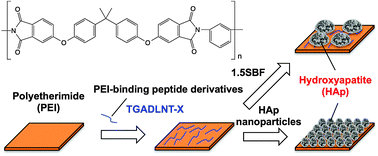Surface functionalization of polymer substrates with hydroxyapatite using polymer-binding peptides†
Abstract
Material-binding peptides are used as non-covalent bond linkers for surface functionalization because they bind to materials under mild conditions without affecting the properties of the materials and are functionalized by conjugating with other molecules. In the present study, the surface functionalization of polyetherimide (PEI) with hydroxyapatite (HAp) was examined using two types of PEI-binding peptides conjugated with other sequences. One peptide consisted of PEI-binding peptide p1 (TGADLNT) and a triasparate sequence for the biomimetic mineralization of HAp in simulated body fluids (SBFs), while the other consisted of p1 and HAp-binding peptide (HABP, CMLPHHGAC) for the immobilization of HAp and amorphous calcium phosphate (ACP) nanoparticles. The results obtained revealed deposits of HAp on PEI films treated with the peptide consisting of p1 and triasparate. HAp and ACP nanoparticles were immobilized on PEI films treated with peptides consisting of p1 and HABP, and immersion of the resultant substrates in SBFs completely covered the surfaces of PEI films with HAp.


 Please wait while we load your content...
Please wait while we load your content...